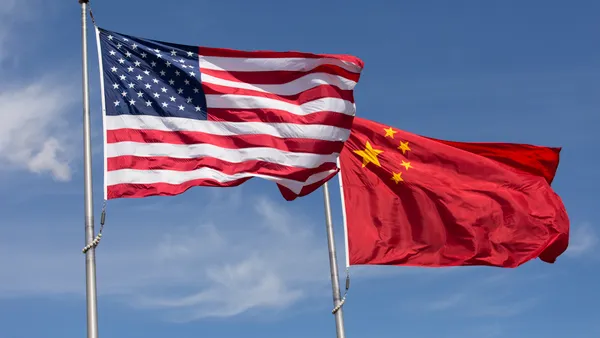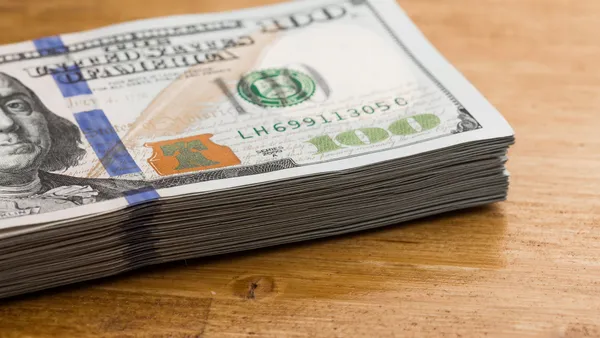Dive Brief:
- President Donald Trump on Wednesday announced a 90-day pause on some tariffs on goods from most U.S. trade partners while raising import duties on China’s exports to 125% and accusing Beijing of “ripping off” the U.S.
- More than 75 countries have reached out to federal officials seeking trade negotiations and “have not, at my strong suggestion, retaliated in any way, shape, or form” against the U.S., Trump said, triggering a partial reversal in a multi-day plunge in U.S. stock markets.
- “I have authorized a 90-day pause, and a substantially lowered reciprocal tariff during this period, of 10%, also effective immediately,” he said on Truth Social, referring to duties that took effect earlier Wednesday.
Dive Insight:
Trump announced a partial pullback from a trade war that has prompted forecasts of recession and turmoil in both bond and equity markets.
JPMorgan Chase CEO Jamie Dimon, speaking Wednesday before Trump’s announcement, predicted that the barrage of tariffs will trigger a recession.
“I am going to defer to my economists at this point, but I think probably that's a likely outcome,” Dimon said during an interview on Fox Business.
“I always remind people, markets aren't always right, but sometimes they are right, and I think this time they are right,” Dimon said, noting weakening business sentiment.
Trump has faced pressure to pause tariffs from several quarters, including Wall Street, academia and Capitol Hill.
“Developments in the last 24 hours suggest we may be headed for [a] serious financial crisis wholly induced by U.S. government tariff policy,” former U.S. Treasury Secretary Lawrence Summers said Wednesday on X before Trump’s partial reprieve.
“Long-term interest rates are gapping up, even as the stock market moves sharply downwards,” according to Summers, a Harvard University economics professor. “We are being treated by global financial markets like a problematic emerging market.”
Summers was not reassured by Trump’s 90-day pause.
“Even their new regime has tariffs near Smoot-Hawley levels and will cost middle class families close to $2,000,” he said. “We are far from being out of the woods. Much credibility has been lost. Be afraid.”
The yield on the 10-year Treasury note, a benchmark for mortgages, corporate borrowing and other debt, rose to 4.35% Wednesday from 3.87% on April 4.
“The Stock and Bond Market Vigilantes are signaling that the Trump administration may be playing with liquid nitro,” Ed Yardeni, president of Yardeni Research, said Tuesday in a research note to clients.
“Fixed-income investors may be starting to worry that the Chinese and other foreigners might start selling their U.S. Treasuries,” Ed Yardeni said, noting that the White House may need to announce a 90-day postponement.
Trump raised duties on imports from China to 125% after Beijing said it will retaliate against the U.S. by imposing a 84% tariff on imports from the U.S. beginning Thursday.
If the tariffs announced by Trump last week remain in force for the remainder of 2025, the Conference Board estimates that the U.S. economy would shrink by 1.2% this year and unemployment would rise to 4.7% from 4.2% as 1.1 million workers lose their jobs.
“The bottom line is that tariffs are no good for anyone, and certainly they are more damaging to the economy who imposes them first than the economies who are being imposed upon,” Conference Board Chief Economist Dana Peterson said Wednesday during a webcast.
“When you have economies that retaliate, we see slower growth across the board, because it shrinks both exports and imports, because you're destroying demand and you're also upsetting supply,” she said.
Yet the Conference Board is not forecasting a recession for 2025, Conference Board Senior U.S. Economist Yelena Shulyatyeva said, noting the possibility that the U.S. and its trading partners will negotiate tariff reductions.
Instead, gross domestic product will likely grow 1.6% in 2025 after expanding 2.8% last year, assuming imposition of some reciprocal tariffs, Shulyatyeva said.
“Growth will substantially slow down, but at the same time the fundamentals in the U.S. economy will allow it to kind of weather the storm,” she said.











